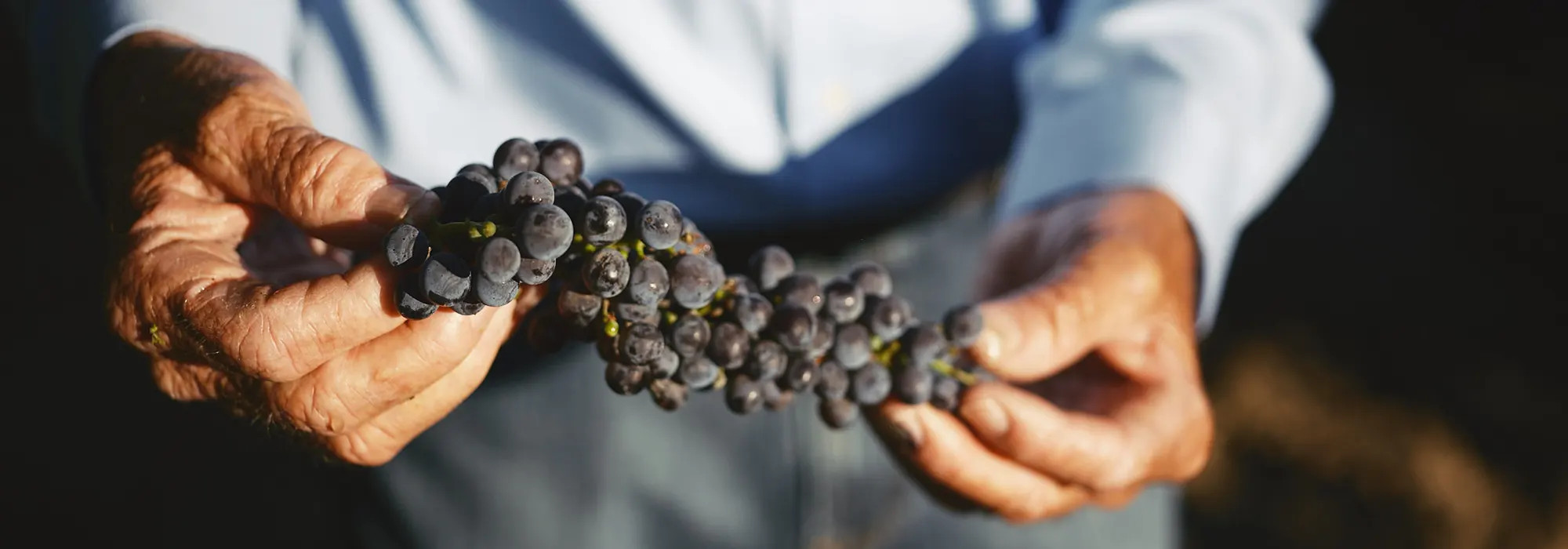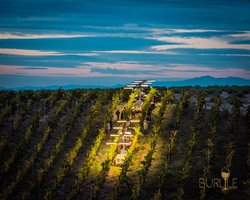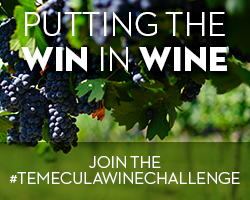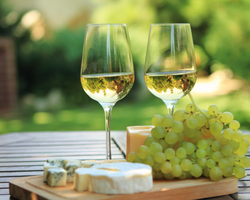White Wine and Cider Brined Roasted Turkey with Swiss Chard, Sausage, Apple, and Dried Plum Stuffing
 A fruity cider and white wine steeped brine is key to this moist and flavorful turkey. Begin the brining process 2 days before roasting. Pair with your favorite Temecula Valley Chardonnay or Merlot.
A fruity cider and white wine steeped brine is key to this moist and flavorful turkey. Begin the brining process 2 days before roasting. Pair with your favorite Temecula Valley Chardonnay or Merlot.
Serves 8
Ingredients:
A fruity cider and white wine steeped brine is key to this moist and flavorful turkey. Begin the brining process 2 days before roasting. Pair with California Chardonnay or Merlot.
Serves 8
Ingredients:
Brine:
8 cups water
1 cup kosher salt
1 cup sugar
1 small yellow onion, quartered
4 garlic cloves
3 bay leaves
1/2 tablespoon black peppercorns
4 cups apple cider
1 bottle white wine
1 (12 to 14 pound) turkey, neck and giblets removed
1 small yellow onion, quartered
1/2 lemon, halved
1 bunch thyme
1 bunch sage
8 tablespoons unsalted butter, melted
Brine and air-dry the turkey:
Bring the water, salt, sugar, onion, garlic, bay leaves, and peppercorns to boil in a large pot, stirring to dissolve the salt and sugar. Remove from the heat, add the cider and wine, and cool to room temperature. Place the turkey, breast-side up in a large container. Pour the brine over the turkey, adding more cold water, as needed, to cover. Refrigerate the turkey for 24 hours, turning the turkey once or twice in the brine.
Remove the turkey from the brine, discard the brine, and pat the turkey dry with paper towels. Place the turkey, breast-side up, on a rack in a roasting pan and refrigerate, uncovered, at least 8 hours or overnight to allow the skin to thoroughly dry out. Remove from the refrigerator 1 hour before roasting.
Roast the turkey:
Heat the oven to 350°F.
Loosely stuff the turkey cavity with the onion, lemon, thyme, and sage. Tie the legs together with kitchen string. Roast the turkey in the oven, about 15 minutes per pound, or until the juices run clear when pierced at the thickest part of the thigh. Baste the turkey with the melted butter at first, and then the pan juices every 20 to 30 minutes. If the breast browns before the turkey is fully cooked, loosely cover with foil.
Remove the turkey from the oven and transfer to a cutting board. Loosely cover with foil and let rest 30 minutes before carving. Serve with Swiss Chard Stuffing (see below).
Swiss Chard, Sausage, Apple, and Dried Plum Stuffing:
12 ounces pitted dried California plums, about 20, halved
1/2 cup dry white wine
1 (1-pound) loaf sourdough bread, cut into 1-inch pieces
1/4 cup plus 1 tablespoon olive oil
12 ounces Italian sausage, casings removed, crumbled
2 Granny Smith apples, cored, cut into 1/2-inch pieces
1 large yellow onion, chopped
8 green Swiss chard leaves, about 12 ounces, ends trimmed, leaves coarsely chopped
4 tablespoons unsalted butter, softened
2 tablespoons chopped fresh sage leaves
1 tablespoon chopped fresh thyme
1 teaspoon salt
1/2 teaspoon freshly ground black pepper
1 cup chicken stock
Directions:
Combine the pitted dried plums and wine in a small bowl. Let stand while you prepare the stuffing.
Heat the oven to 400°F. Butter a 13 x 9-inch baking dish.
Toss the bread with 1/4 cup oil and spread on a rimmed baking sheet. Bake in the oven until light golden, 10 to 12 minutes. Remove and cool.
Decrease the oven temperature to 350°F. Heat the 1 tablespoon oil in a large skillet over medium heat. Add the sausage and cook until golden brown, 6 to 8 minutes. Transfer the sausage with a slotted spoon to a large bowl. Do not discard the fat from the skillet.
To the same skillet, add the apples and onion and sauté over medium heat until the onions soften, about 5 minutes. Add the chard and cook until the leaves wilt, about 5 more minutes. Stir in the dried plums and wine, the butter, sage, thyme, salt, and pepper and cook, stirring, until the butter melts. Remove from the heat and add to the sausage, then add the bread and chicken stock; stir to thoroughly combine.
Pour the dressing into the prepared baking dish and cover with foil. Bake for 15 minutes, then remove the foil and bake until brown and crisp on top, about 30 more minutes.
Recipe and photo courtesy of The Wine Institute of California



 Mom’s stuffing, Aunt Nancy’s cranberry sauce and your sister’s sweet potatoes. Menu: done! But what about the wine? Choosing a bottle (or two!) of wine to bring to the holiday table can be tricky. Appealing to not only your menu, but to a cross-section of practiced palates and novice wine drinkers may seem challenging. But don’t stress out over one of the simplest tasks of the holiday season. Make it simple. Any wine you enjoy is a good wine!
Mom’s stuffing, Aunt Nancy’s cranberry sauce and your sister’s sweet potatoes. Menu: done! But what about the wine? Choosing a bottle (or two!) of wine to bring to the holiday table can be tricky. Appealing to not only your menu, but to a cross-section of practiced palates and novice wine drinkers may seem challenging. But don’t stress out over one of the simplest tasks of the holiday season. Make it simple. Any wine you enjoy is a good wine!
 Mid-week is the best time to taste Temecula Valley wines, as your chances of getting a behind the scenes tour, meeting a winemaker, or snagging a barrel sample run high – you just have to ask! This California Wine Month, take your wine knowledge to the next level. From September 1-30, we invite you to explore Temecula Valley Southern California Wine Country like a true wine photojournalist…and win a cool prize or two while you’re at it.
Mid-week is the best time to taste Temecula Valley wines, as your chances of getting a behind the scenes tour, meeting a winemaker, or snagging a barrel sample run high – you just have to ask! This California Wine Month, take your wine knowledge to the next level. From September 1-30, we invite you to explore Temecula Valley Southern California Wine Country like a true wine photojournalist…and win a cool prize or two while you’re at it.

 Spending the day in Temecula Valley’s Wine Country……well, we can’t think of a better gift for Mom this Mother’s Day! We’ve got you covered with brunches and lunches and everything in between. Here’s a list of wineries celebrating all of the Mom’s out there:
Spending the day in Temecula Valley’s Wine Country……well, we can’t think of a better gift for Mom this Mother’s Day! We’ve got you covered with brunches and lunches and everything in between. Here’s a list of wineries celebrating all of the Mom’s out there: Moscato, Muscatel, Muscat… what’s the difference between them? Just the names, actually. Rather than just being one grape, Muscat includes a family of grapes in a range of colors (from white to brown, or to near black.) For instance, Moscato is the Italian name and Muscatel the Spanish.
Moscato, Muscatel, Muscat… what’s the difference between them? Just the names, actually. Rather than just being one grape, Muscat includes a family of grapes in a range of colors (from white to brown, or to near black.) For instance, Moscato is the Italian name and Muscatel the Spanish.